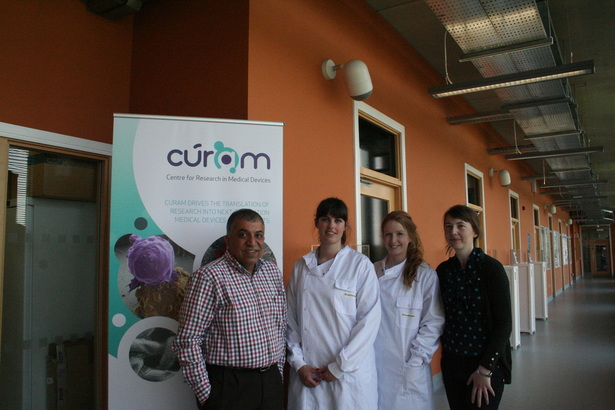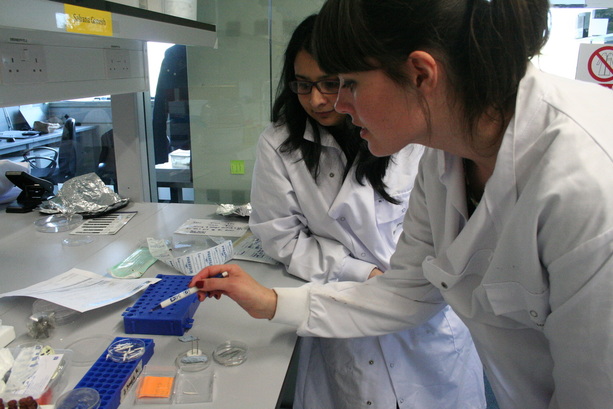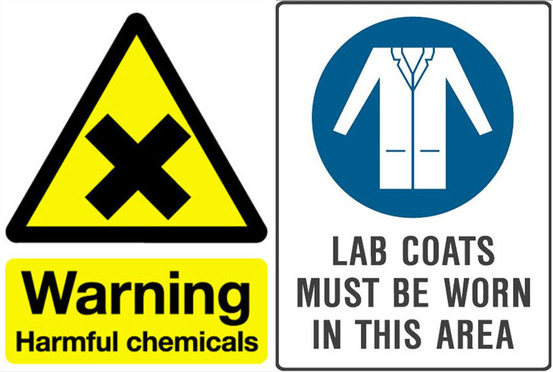This is my residency blog where you can follow my research, biological and medical material investigations and collaborative practice.
I am delighted to be awarded Artist in Residence in the Cúram, Galway. Here I am at my induction day with Prof. Abhay Pandit the Centre Director, fellow artist in residence Joanna Hopkins and the Chimera Art and Science Director Andrea Fitzpatrick in the Biomedical Science building in NUIG.
Research Mission Statement
The Invisible Normal
Advances in medical technologies continue to stretch the parameters of anatomy. Medical interventions that not only replicate human function but enhance them, prolonging life and challenging the limitations of illness. Through a series of investigations I propose to explore how these technologies shape the future of normal anatomy.
I propose to investigate the notion of the invisible normal through explorations of medical devices and drug applications that alter or amend the biology or function of the host. I’m interested in the notion that these life-changing interventions create a new narrative of the everyday for the patients.
Fascinated by the capability of the body to adapt, this project proposes to investigate how human anatomy adapts to medical interventions, in the context of the “internal hybrid”, the intersection between human biology and man made applications. Through in-depth material investigation, I propose to explore the nature of these materials, their biocompatibility and function.
Engrossed by the nature of the human cell to adapt, multiply and transform, I have a particular interest in exploring the unique properties of stem cells to transform into specialized cells. This project seeks to investigate there potential to engineer and regenerate human cells, tissues and organs in order to restore or establish normal function.
As a visual artist that primarily works in the third dimension I have a great interest in the function and creation of form, especially in the context of medical, biological and technical advancements in the extension of the human. I propose to explore the curative architecture of these “internal hybrids”, how are cells are engineered to grow into a specific form, how the mesh of a stent changes the structure of a vessel and the molecular structure of a polymer.
Collaboration and interdisciplinary is a fundamental part of my research and process. I propose to develop an interdisaplinary discourse that generates a wider understanding of implantable medical devices and the possible future trajectory of these advances.
Chimera Art and Science
The Chimera Art and Science programme investigates the meeting point of art and science. The NUI Galway based project, will bring artists and scientists together to create a dialogue around the ethical and cultural issues of tissue engineering and medical devices. CÚRAM, the Centre for Research in Medical Devices, has been awarded funding for the Chimera Art and Science Project. The Chimera project is funded by the Science Foundation Ireland (SFI) Discover Programme which aims to support and develop the STEM education and public engagement sector in Ireland.
This year’s programme will bring together 10 student artists from the Centre for Creative Arts and Media, GMIT and 2 Artists in Residence to work in the laboratories of the Network of Excellence for Functional Biomaterials, National University of Ireland, Galway, to create art works. The programme is curated by Andrea Fitzpatrick.
CÚRAM
The objective for the Centre for Research in Medical Devices (CÚRAM) is to radically improve health outcomes for patients by developing innovative implantable medical devices. Devices will be developed with strong clinical collaborations, with industry partners and hospital groups, to enable rapid translation to the clinic.
CÚRAM will design and create implantable ‘smart’ medical devices. Implants will be designed and manufactured to respond to the body’s environment and to deliver therapeutic agents, such as drugs, exactly where needed. CÚRAM’s outputs will particularly benefit patients with chronic diseases such as heart disease, diabetes and musculoskeletal diseases. As the global population ages, with one in three people expected to be over 65 by 2050, the financial burden for healthcare is expected to rocket. CÚRAM will position Ireland as the driver in developing medical device technologies, which will provide affordable transformative solutions for chronic diseases to meet this challenge. CÚRAM will also sustain and strengthen Ireland’s standing as a major global hub for medical device sector research and development. CÚRAM will include almost 40 industry partners, including indigenous Irish companies and multinationals, and support product development and the creation of new spin-out companies.
Research Mission Statement
The Invisible Normal
Advances in medical technologies continue to stretch the parameters of anatomy. Medical interventions that not only replicate human function but enhance them, prolonging life and challenging the limitations of illness. Through a series of investigations I propose to explore how these technologies shape the future of normal anatomy.
I propose to investigate the notion of the invisible normal through explorations of medical devices and drug applications that alter or amend the biology or function of the host. I’m interested in the notion that these life-changing interventions create a new narrative of the everyday for the patients.
Fascinated by the capability of the body to adapt, this project proposes to investigate how human anatomy adapts to medical interventions, in the context of the “internal hybrid”, the intersection between human biology and man made applications. Through in-depth material investigation, I propose to explore the nature of these materials, their biocompatibility and function.
Engrossed by the nature of the human cell to adapt, multiply and transform, I have a particular interest in exploring the unique properties of stem cells to transform into specialized cells. This project seeks to investigate there potential to engineer and regenerate human cells, tissues and organs in order to restore or establish normal function.
As a visual artist that primarily works in the third dimension I have a great interest in the function and creation of form, especially in the context of medical, biological and technical advancements in the extension of the human. I propose to explore the curative architecture of these “internal hybrids”, how are cells are engineered to grow into a specific form, how the mesh of a stent changes the structure of a vessel and the molecular structure of a polymer.
Collaboration and interdisciplinary is a fundamental part of my research and process. I propose to develop an interdisaplinary discourse that generates a wider understanding of implantable medical devices and the possible future trajectory of these advances.
Chimera Art and Science
The Chimera Art and Science programme investigates the meeting point of art and science. The NUI Galway based project, will bring artists and scientists together to create a dialogue around the ethical and cultural issues of tissue engineering and medical devices. CÚRAM, the Centre for Research in Medical Devices, has been awarded funding for the Chimera Art and Science Project. The Chimera project is funded by the Science Foundation Ireland (SFI) Discover Programme which aims to support and develop the STEM education and public engagement sector in Ireland.
This year’s programme will bring together 10 student artists from the Centre for Creative Arts and Media, GMIT and 2 Artists in Residence to work in the laboratories of the Network of Excellence for Functional Biomaterials, National University of Ireland, Galway, to create art works. The programme is curated by Andrea Fitzpatrick.
CÚRAM
The objective for the Centre for Research in Medical Devices (CÚRAM) is to radically improve health outcomes for patients by developing innovative implantable medical devices. Devices will be developed with strong clinical collaborations, with industry partners and hospital groups, to enable rapid translation to the clinic.
CÚRAM will design and create implantable ‘smart’ medical devices. Implants will be designed and manufactured to respond to the body’s environment and to deliver therapeutic agents, such as drugs, exactly where needed. CÚRAM’s outputs will particularly benefit patients with chronic diseases such as heart disease, diabetes and musculoskeletal diseases. As the global population ages, with one in three people expected to be over 65 by 2050, the financial burden for healthcare is expected to rocket. CÚRAM will position Ireland as the driver in developing medical device technologies, which will provide affordable transformative solutions for chronic diseases to meet this challenge. CÚRAM will also sustain and strengthen Ireland’s standing as a major global hub for medical device sector research and development. CÚRAM will include almost 40 industry partners, including indigenous Irish companies and multinationals, and support product development and the creation of new spin-out companies.
Induction day
Wednesday 23rd April
The morning stared out with a informal meet and greet between fellow artist in residency Joanna Hopkins and Chimera arts and science director Andrea Fitzpatrick, of whom I had the pleasure of working with before in a previous Chimera exhibition.
Shortly after armed with pen and paper and clad in laboratory coats we embarked on an intensive induction to health and safety in the laboratories where we discussed the various chemical and physical hazards we will encounter on a daily basis and safe working practice in the lab’s.
We were assigned desks in the laboratory for medical and biological investigations and creations, which we have access to from Monday- Friday between the hours of 9-5. Hot desks are also available for research, admin, drawing and digital practice and we have also have access to the NUIG library.
Wednesday 23rd April
The morning stared out with a informal meet and greet between fellow artist in residency Joanna Hopkins and Chimera arts and science director Andrea Fitzpatrick, of whom I had the pleasure of working with before in a previous Chimera exhibition.
Shortly after armed with pen and paper and clad in laboratory coats we embarked on an intensive induction to health and safety in the laboratories where we discussed the various chemical and physical hazards we will encounter on a daily basis and safe working practice in the lab’s.
We were assigned desks in the laboratory for medical and biological investigations and creations, which we have access to from Monday- Friday between the hours of 9-5. Hot desks are also available for research, admin, drawing and digital practice and we have also have access to the NUIG library.
Andrea allocated a mentor for each of us who’s research is relevant to our practice. My mentor is Dr. Siti Ismail, whose research area is mesenchymal stem cells. I will write more about her exciting field of research in the coming weeks.
In the afternoon two of the scientist gave informal presentation of their research. Isma Lisa Mohd Isa talked about her research into treatment for chronic lower back pain; she is developing a bio gel that has the potential to be surgically implanted into the spine to regenerate the degenerative matrix material.
Sahana Ganesh introduced us to her research into creating artificial pathways for nerves for the treatment of nerve damage. Sahana is manufacturing these from proteins taken from a cow. I’m very excited about the potential this material has for the creation of bio-art.
It was clear from these two talks just how innovative the work of the researchers in the CURUM is and also how relevant the work is to my research into the technologies that extend the human. I think it will take some time to figure out which projects are most relevant to my project, but I look forward to figuring this out and all the researchers I will meet in-between.



